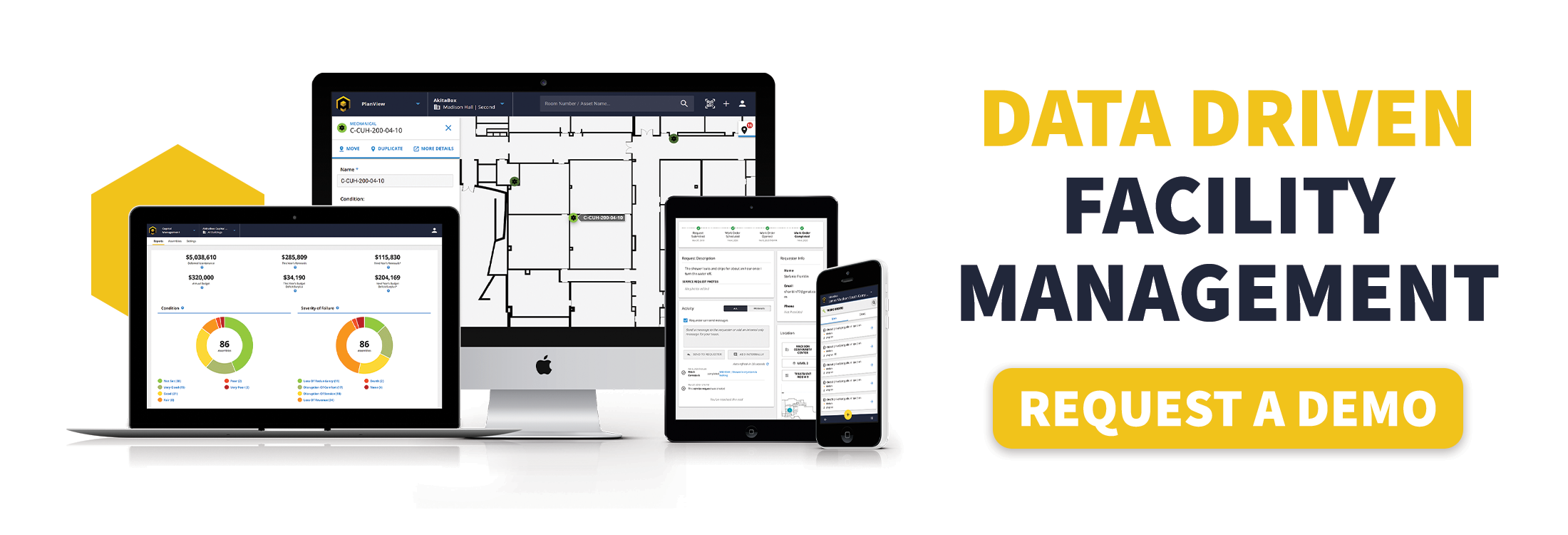How Local Governments Can Use Facilities Management Software to Solve 6 Big Problems
From police and fire departments to municipal courts and public works, our local governments provide incredibly important services. Without a reliable facilities team to keep everything running smoothly, these services would quickly run into problems.
Because it’s such an important part of local government, facilities management is under intense pressure to perform. Yet many facilities departments are struggling with outdated tools, shrinking budgets, and retiring staff members.
Here are 6 problems local government facilities teams face – and how a comprehensive facilities management software solution can solve each one.
Problem: My facilities data (including my floor plans) is an outdated mess
Many local governments are facing 21st century problems armed with 20th century tools and techniques. Does any of this sound familiar?
- Outdated paper floor plans
- Siloed data scattered in multiple locations
- No central repository for all facilities information
- Paper records stuffed in binders and file folders
- Basic Excel spreadsheets and Word documents
- No measurable way to track metrics and KPIs
Without complete, accurate data, it’s incredibly difficult to manage government facilities efficiently, safely, and cost-effectively.
Solution: Digital data repository
Imagine all of your facilities data in one place, accessible to your entire team. Need the warranty information for your boiler? Done. Need the maintenance history of the water heater? No problem. Need to share current floor plans with another department? Here you go.
Pretty amazing, right? That’s the power of facilities management software. It stores all of your facilities data in a digital format that’s easily accessible by everyone on your team.
One of the biggest advantages of FM software? Up-to-date digital floor plans. During FM software implementation, some software partners (like AkitaBox) will take your existing floor plans, digitize them, and then update them. In addition, some software partners will collect all of your facilities data and put it into the software for you.
Challenge: I don’t know what’s inside my buildings
Local governments are responsible for an incredible variety of spaces – public health buildings, courthouses, park shelters, wastewater treatment plants, and the list goes on. All these facilities are unique, with very different purposes.
Keeping track of rooms and equipment in dozens of buildings is no easy task – especially if you’re relying on your memory or outdated lists. How can you hope to efficiently manage multiple facilities and millions of square feet if you’re not even sure what’s inside each building?
Solution: Location-based asset mapping
Some types of FM software can map your assets to your digital floor plans. Whether it’s electrical panels, light fixtures, power generators, drinking fountains, or even trash cans, you can track the location of any asset you want.
Asset locations appear as color-coded pins on your digital floor plan. It’s easy to see what assets you have in each location and precisely where they live. Now you can:
- More accurately inventory your assets
- Create efficient routes for regular maintenance, cleaning, and inspections
- Show a new team member or outside contractor exactly where to find an asset
See how it works in the video below. (Full disclosure: not all FM software tools can do this, so keep that in mind when considering solutions).
Challenge: I’m stuck in a reactive maintenance spiral
Wood County, Wisconsin, once felt your pain on this one. Their aging and underfunded facilities contributed to a very reactive, costly, and time-consuming maintenance program.
Of course they wanted to shift to a more proactive approach, but paper-based work order processes, inaccurate maintenance histories, and no real way to track their asset life cycles were holding them back.
When reactive maintenance needs start piling up, it can crush your team under a mountain of costly emergencies that seems impossible to dig out of.
Solution: Better work order management
You’ll struggle to implement a preventive maintenance (PM) program if you don’t get your day-to-day, reactive maintenance under control first. FM software gives team members instant access to work orders, which eliminates paper waste, improves productivity, and gives you historical documentation of any work completed.
Wood County can attest. Using AkitaBox, they’ve gotten a better handle on their reactive work so they have more bandwidth to dedicate to preventive maintenance. Explore the full case study.
The reporting function of FM software helps you keep an eye on maintenance activities across your buildings. Ensure work orders are being completed. And spot potential problems before they get out of control.
When it comes to preventive maintenance, FM software can automate PM task scheduling. It also gives your techs instant access to any asset information and PM protocols they may need while out in the field. In addition, FM software holds your team accountable to any tasks they’re assigned.
Read More:
Challenge: I’m overwhelmed with too much manual work
The 2022 State of Local Government Survey found a majority of local governments across the country struggle with a lack of resources and too much manual work.
- 44% – too few resources
- 34% – too much manual work
Whether it’s clunky processes that require lots of back and forth or old-fashioned paper-based systems, these challenges slow you down and reduce the impact of your work.
Using an FM platform can remove inefficiencies and reduce the need for additional resources to maintain your facilities.
Solution: Streamline and automate processes
In 2021, 39% of local governments were prioritizing investments in technology to automate repetitive tasks and repetitive workflows. That’s a large part of what FM software does.
By automating historically time-consuming, labor-intensive tasks such as managing work orders, inputting asset information, and conducting regular inspections, FM software enables your team to get more done, get it done faster, and not need as many people to do it.
The service request portal included in FM software is just one example.
- Instead of an occupant calling in or emailing a service request to the maintenance department, they can submit it via the interactive portal.
- You can review and schedule the work order in seconds, with the software automatically updating the occupant on the status of their request.
- Your maintenance tech is automatically notified they have a work order and can pull up any information they need to complete it.
There’s no need for someone to spend their day organizing all the work orders, following up with the techs to ensure they’re completing them, and responding to occupant requests for a status update.
Challenge: If one of my techs leaves (even just for vacation), I’m screwed
Adequate staffing is a huge concern according to the 2022 State of Local Government Survey.
- 54% are not confident they’ll be able to recruit the talent they need to replace leaving employees
- 62% say if they took a two-week vacation, there is no one who could easily perform their duties in their absence
When the one person on your facilities team who has the most institutional knowledge takes a well-deserved vacation, leaves for another role, or retires, where does that leave the rest of your team? Up a creek without a paddle, most likely.
You need a way to share the invaluable information in the brains of your more experienced techs with the rest of your team.
Solution: Effective knowledge transfer
FM software is a repository for all of your facilities data – from the location of that one hard-to-find asset to notes on how to keep the cranky AC unit from acting up. It’s fully digital, so anyone on the team can access whatever data they need right from their mobile devices.
FM software makes it easy for people to cover unfamiliar buildings or processes when someone is out of the office. In fact, Oldham County, Kentucky, cut down the amount of multiple trips to the same site by 75% after they began using AkitaBox for facilities management. Their team could better anticipate what they needed before leaving because they could access all the necessary data in the software. It’s the ultimate knowledge transfer tool.
Having all of your facilities data housed in your FM software prevents work from piling up while an employee is out on vacation. If an employee does end up leaving, remaining team members can quickly take over their job duties. And using technology like FM software makes working on your particular maintenance team more desirable to potential new hires.
Read More:
Challenge: My local government wants greater transparency & collaboration
The 2022 State of Local Government Survey highlights the growing need for better cooperation across departments. More than half of the respondents said the greatest opportunity for overall collaboration across departments is adopting technology that brings together data across sources.
There’s also a push towards more strategic and transparent capital planning. Nearly 70% of local governments are working to make capital planning more strategic, transparent, or collaborative.
Your facilities data is the key to greater capital planning transparency and overall collaboration with other departments. It’s a powerful tool – if you can leverage it effectively.
Solution: Transparency through data
FM software allows you to track, collect, organize, and share accurate, up-to-date facilities information. It pulls together multiple data streams (maintenance activities, asset conditions, etc.) to give a clear picture of your overall situation. Armed with this information, you can:
- Create more accurate capital budgets (and show the data you used to come up with your budget)
- Illustrate the costs and risks of deferring capital purchases and projects
- Give data-backed input to other departments
- Serve as a trusted resource for any facilities-related questions
With FM software, you can leverage your facilities data to support greater collaboration and transparency throughout your organization.
Read More:
AkitaBox: Facilities Management for Local Governments
AkitaBox is a complete facilities management solution for state and local governments, providing:
- Asset management
- Maintenance management
- Capital planning
- Inspections
See for yourself how we can help you overcome some of your biggest FM pain points. Request a demo today!




